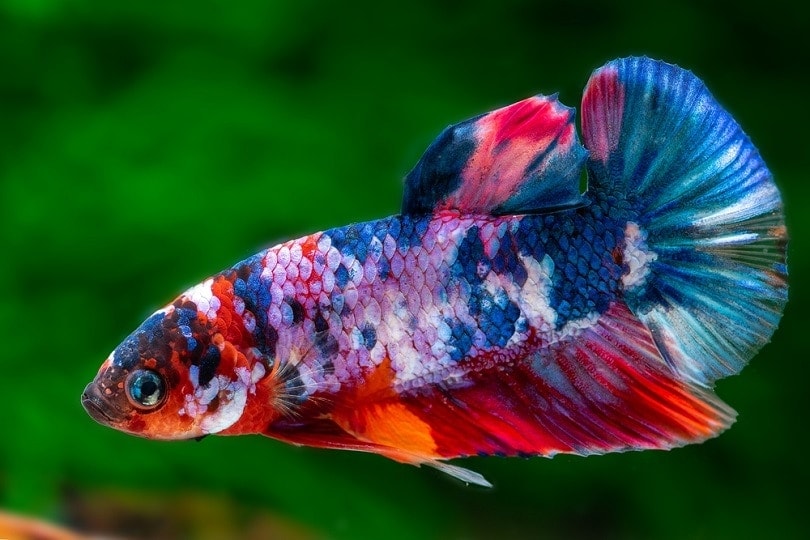
There is an endless amount of filter media available to fit a variety of different aquariums, and each type of filter media can play an important role in how well your aquarium functions as well as the quality of the water.
With so many different filter media available, it can be difficult to determine which media will be worth the investment and placement in your filter, and which types will be a waste of your time and money. That’s why we have put together this article with some popular and effective filter media options that can easily fit into sump or canister filters to offer you either mechanical, biological, or chemical filtrations.
 The 7 Top Aquarium Filter Media Options
The 7 Top Aquarium Filter Media Options
1. Filter Floss
This is a form of mechanical filter media. It helps to collect debris in an aquarium by capturing the particle waste in the wooly texture and preventing it from going to the outlet of the filter system. Filter floss can easily be used in canister filters and makes a good water polisher. It’s made from 100% polyester and is relatively inexpensive at most local fish stores.
Some types of filters allow you to pack the filter floss tightly together to form a strong surface for large particles to travel through that are taken in by the filter. It is best to place the filter floss where the intake of water flows so that the filtered water can then pass through any chemical media in the filter.
2. Activated Carbon
Carbon is highly effective at removing odors, medications, chemicals, and discoloration from the aquarium when used in a filter. Activated carbon comes in a variety of different shapes and sizes, such as the thin chips or the pelleted version. It’s also highly porous which allows beneficial bacteria to flourish.
It is recommended to replace the activated carbon when you do filter cleanings because this type of media can only hold a certain amount of chemicals and impurities from the water before it stops working, and can instead slowly release these impurities back into the water. Most aquarists recommend changing the activated carbon every 2 to 4 weeks depending on the size of the aquarium and the type and amount of activated carbon you are using.
3. Ammonia Chips
These are ammonia-absorbing granules that are porous and allow beneficial bacteria to grow, plus help to reduce ammonia levels that may spike in aquariums with heavy bio loads. You can also use ammonia chips when transporting fish and invertebrates, as they may begin to produce more waste from being stressed and the ammonia chips can help keep the levels low—which would spike from the high amount of poop in the water.
Just like with most filter media, ammonia chips should be replaced every couple of weeks so that each batch can work properly.
4. K2 Biological Media
This is a type of self-cleaning filtration that consists of floating plastic media. This type of filter media has primarily been used in waste management and fish farms for almost a decade and has recently made its way into the aquarium hobby. This media is mostly used in sumps with strong air stones that can push the media so that it tumbles around to help break down waste in the aquarium.
K2 biological media is also great for providing aquariums with aeration while being a breeding ground for good beneficial bacteria.
5. Granular Ferric Oxide (GFO)
This looks like carbon except it has a deep red coloration. It is used as a filter media in reef tanks to remove phosphates and silicates. However, it can also be used in freshwater aquariums that have severe algae problems. It can be quite dusty so it should be thoroughly rinsed under water to remove excess red dust and colorants that may turn your water slightly red.
Phosphates and silicates are known to cause algae issues in tanks, so this filter media can be used to help keep excess algae growth under control.
6. Crushed Coral
Crushed coral does not fall under a specific type of chemical, biological, or mechanical media, but it is a great additive to filters to help increase the pH and KH of the water chemistry depending on the type of fish and invertebrates you have. Some livestock will prefer higher pH and KH levels and if your tap water does not already provide them with the right levels, you can use crushed coral to slowly increase these levels by placing it in the filtration system.
7. Peat Granules
Instead of increasing the pH or KH of an aquarium, peat granules do the opposite and instead lower these levels. This can be beneficial if you have fish and invertebrates that prefer the water chemistry to have low levels of pH and KH. This is because peat releases tannins and tannic acids that cause the pH and KH to drop, but it may also cause the aquarium’s water to turn a slightly yellow color.
Conclusion
Each type of filter media has something different to offer your aquarium and the way it will help improve your aquarium. Most filter media can be used together, and filters typically have more than two compartments so that you can use each filtration space for various media that each has a specific use and benefit.
For example, you can combine activated carbon, ammonia chips, and filter wool into one filter if it has enough space. This will then allow you to incorporate maximum filtration potential into your aquarium by using all three types of filtration (mechanical, chemical, and biological).
Featured Image Credit: M-Production, Shutterstock

 The 7 Top Aquarium Filter Media Options
The 7 Top Aquarium Filter Media Options





